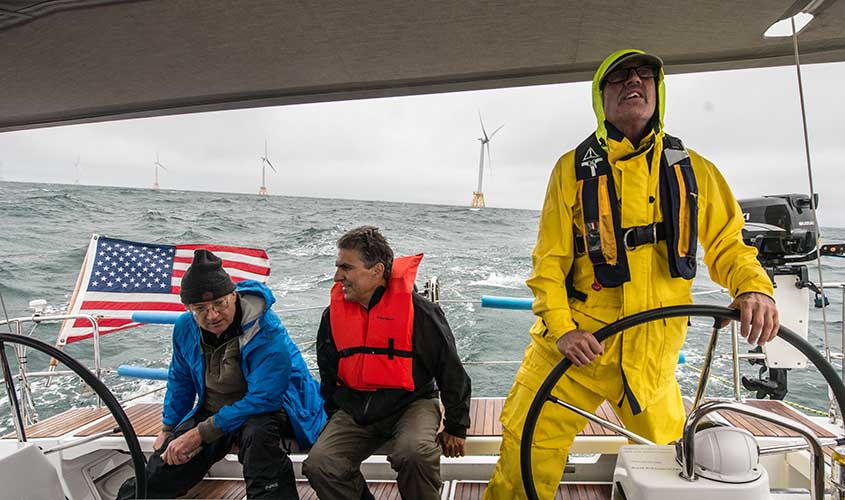Growth in Offshore Wind Energy Offers Huge Opportunity To Create U.S. Jobs
New Study Examines How Industry and Educational Programs Could Help Promote Domestic Workforce Growth
In the smallest town in the country’s smallest state, something big has happened.
In 2016, the residents of Block Island, a 7-mile-long and 3-mile-wide island off the coast of Rhode Island, traded their five diesel generators for five offshore wind turbines. “Now, we are 100% green electrons floating around Block Island,” Bryan Wilson, who manages the wind farm on behalf of Ørsted, said in a video interview. “That’s an amazing feat.”
Block Island’s wind farm may be small like its island, but the project’s success marks the beginning of significant growth in offshore wind energy across the United States. This boom could help the country achieve the Biden administration’s goal to install 30 gigawatts of offshore wind energy by 2030. That growth also presents a big opportunity for the U.S. wind energy industry to create up to tens of thousands of jobs.

And yet, this big opportunity comes with some big unknowns. Like, for example, how many domestic, versus international, jobs the industry could add—and in which sectors and roles—plus what skills and training workers might need to fill those jobs.
Now, experts at the National Renewable Energy Laboratory (NREL) have published a new report titled U.S. Offshore Wind Energy Workforce Assessment, with support from the U.S. Department of Energy’s Wind Energy Technologies Office. The study is the first national-level evaluation of the U.S. offshore wind energy industry’s workforce gaps and opportunities. The report examined what the blossoming industry might need to grow a domestic workforce as well as what educational opportunities are needed to train that workforce. The authors also offer specific actions that industry and other stakeholders could take to capitalize on this huge workforce opportunity.
“This report is like a workforce equation. You have demand and supply,” said Jeremy Stefek, an NREL researcher and co-author of the study. “How do you make sure that industry demand and workforce supply are aligned?”
The study estimates that from 2024 to 2030, the offshore wind energy industry will need an annual average of between 15,000 and 58,000 full-time workers, based on the proportion of domestic content (materials and goods made in the United States) used in offshore wind energy development and construction. The range assumes 25% and 100%, respectively.
And while most of these new jobs are expected to be added in the manufacturing and supply chain sectors, this growth also depends on the construction of new manufacturing and supply chain facilities within the United States. The study also estimates job growth in project development, installation (ports and vessels), operations, and maintenance. Within all of these sectors, jobs fall into more than 100 distinct roles, including finance, engineering, and maritime and other skilled trades.
“Skilled trades are some of the most important positions for the offshore wind energy industry,” Stefek said. “It represents a pretty big gap that will need to be filled for the industry to grow.”
According to the report, the offshore wind energy industry could face steep competition for these skilled workers, which are in high demand across the energy sector. Because their skills are often highly transferable, there is an opportunity for the offshore wind energy industry to entice workers from other offshore industries, like oil and gas or fishing, to join theirs.
And yet, these and other potential workers will need proper training—especially in safety—to effectively and efficiently transition into the offshore wind energy industry. The report identifies 44 education and training programs focused on offshore wind energy. Some of these are the result of successful partnerships between industry, education institutions, and states.
But, the report notes, additional program development will likely be needed to meet demand over time, particularly to train skilled tradespeople, provide safety training to offshore workers at sea, and support workers with transferable skills to transition into the offshore wind energy industry.
To meet this demand, the report’s authors recommend that stakeholders:
- Continue to build regional collaborations between industry, educational and training programs, and national, state, and local governments to align efforts to grow and train a domestic workforce (for example, the recent Federal-State Offshore Wind Implementation Partnership, a collaboration between East Coast state governors and White House administrators, could help support equitable job growth in the U.S. offshore wind energy industry).
- Align and standardize safety training for offshore wind energy workers; the report indicates this is one of the highest priorities to ensure an adequately trained workforce is available to build projects.
- Design programs and initiatives that create a diverse workforce and target communities most impacted by offshore wind development, like those transitioning from fossil-fuel industries, to help jump-start the industry and ensure equitable distribution of jobs and economic benefits.
“Our report offers high-level takeaways for every part of the industry, whether you’re a community college, a four-year degree program, or a union,” said Chloe Constant, a senior project leader at NREL and a co-author of the report. “I hope this study helps clarify where efforts are aligned and where they aren't so these stakeholders can take actions to help the industry realize the greatest domestic job opportunity.”
Next, the study’s authors plan to perform more in-depth analyses of regional gaps and opportunities, the timeline of when jobs might be added to the pipeline, and what specific sectors, like manufacturing, might need.
To build Block Island’s five new offshore wind energy turbines, Ørsted employed about 300 local workers. As the country builds far larger offshore wind farms, the exact number of domestic jobs might still be in question, but the U.S. Offshore Wind Energy Workforce Assessment provides the country with the guide it needs to capitalize on this momentous opportunity.
Eager to learn more? Read the U.S. Offshore Wind Workforce Assessment report. Explore NREL's research in wind energy workforce development or offshore wind energy, and sign up to NREL's wind energy newsletter.

